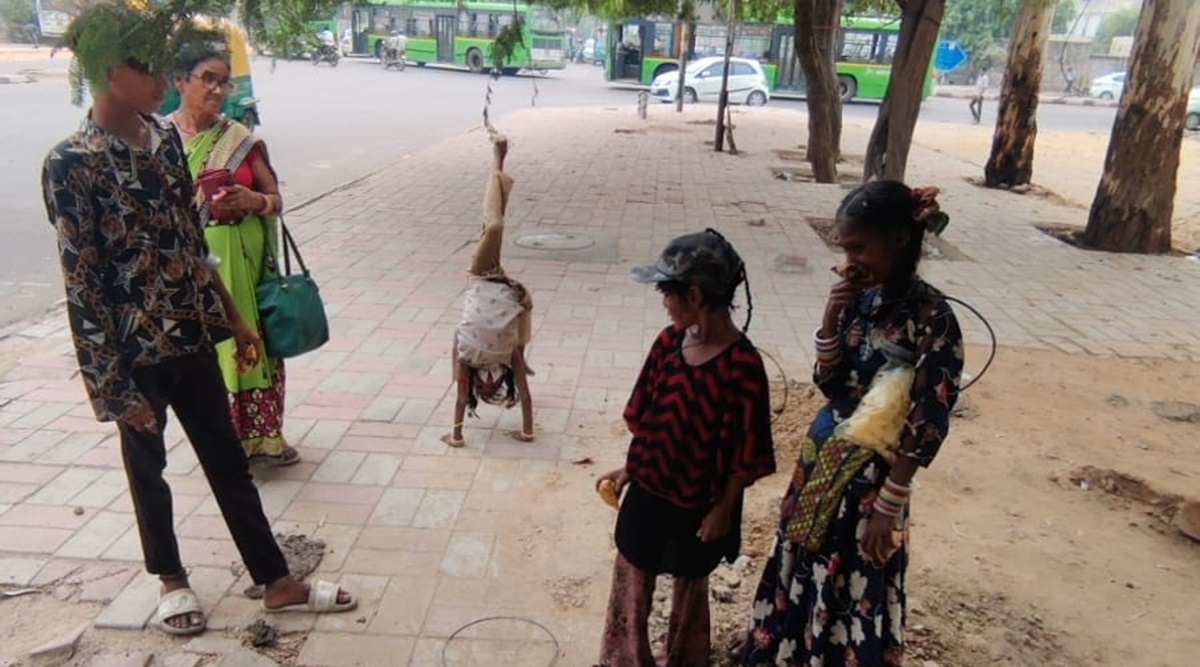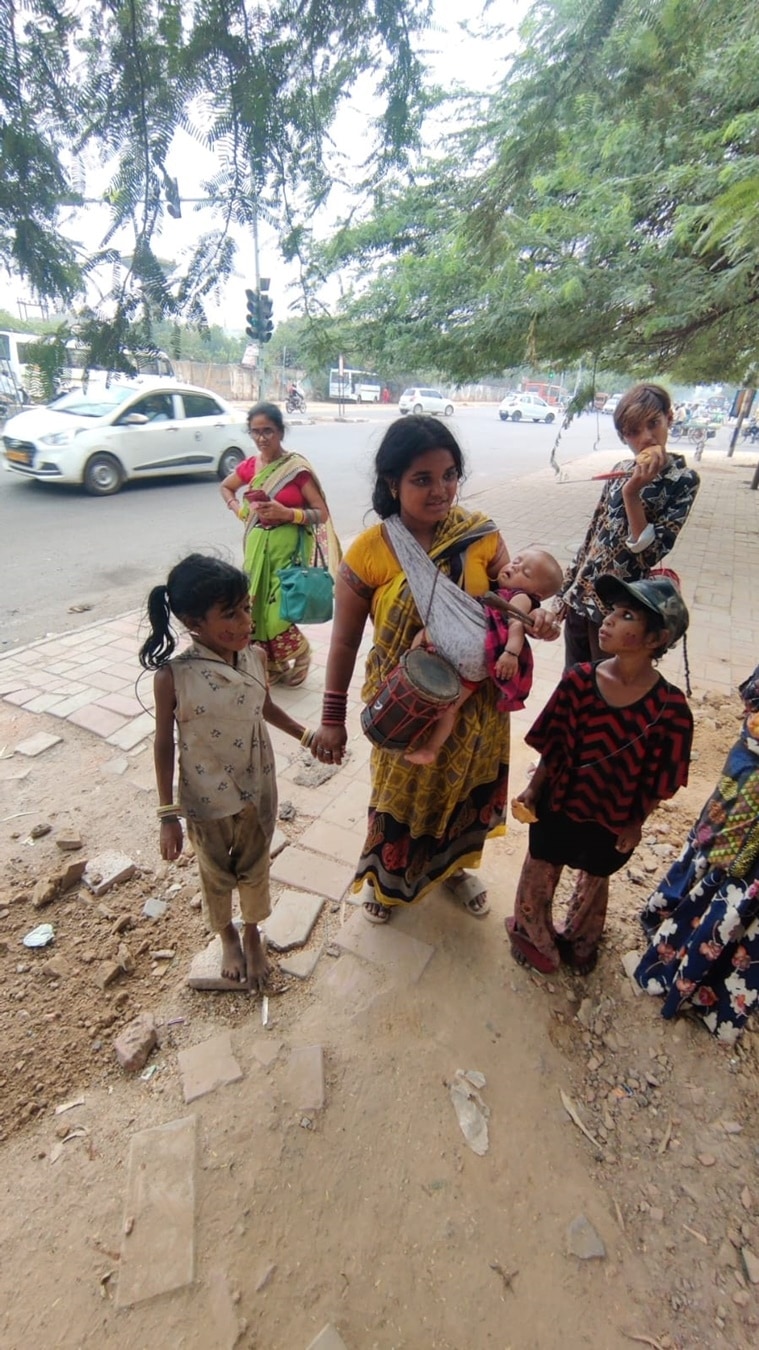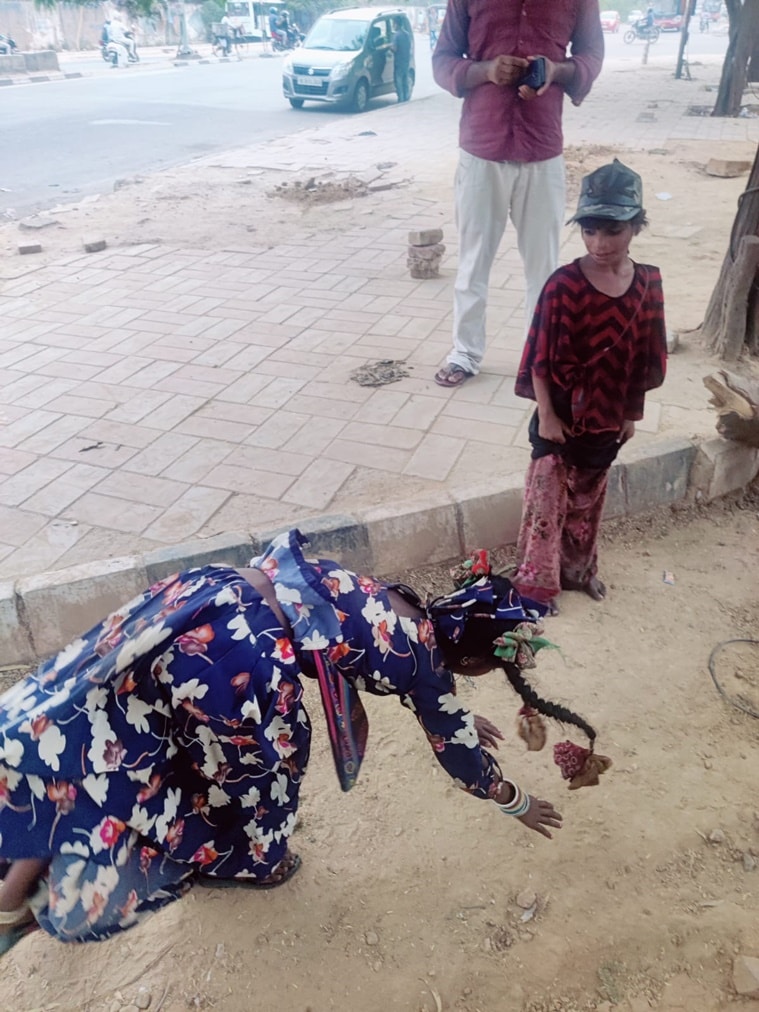 Very few people from the Nat community perform now. They are lost in the crowd of drivers, sweepers and manual labourers. (Photo: Aditi Narayani Paswan)
Very few people from the Nat community perform now. They are lost in the crowd of drivers, sweepers and manual labourers. (Photo: Aditi Narayani Paswan)Delhi, a city to behold, a space to evolve and breathe and to get lost in thoughts. The architectural grandeur of Delhi is breathtaking: from intricate Mughal relics to magnificent and the so-called elite Lutyens. Every corner has tons of untold tales; every individual who has made Delhi, has boundless narratives of communities migrated from thousands of kilometres away.
One such community, which all of us have encountered while waiting at a traffic signal is ‘Nats’ — lean women with big, brown kohled eyes, painted faces and contoured features performing acrobatics.
I struck up a conversation with Rani — a 21-year-old with an infant in her arms — and her seven-year-old child Bharti performing acrobatics to the tunes of dafli. Rani found glimpses of her own ‘shringaar‘ in my lipstick, explaining how the shade of my lipstick was like the shade she used in her childhood — and uses even now — to draw sun-like figures on their faces which brings them good luck.
Best of Express Premium
 Rani and her children. (Photo: Aditi Narayani Paswan)
Rani and her children. (Photo: Aditi Narayani Paswan) All colours have some significance, like black is usually used to denote power, evil, death, while red is used for passion, danger, and energy. Blue denotes peace, confidence and affection, and greens are usually used for life, growth and healing. White symbolises hope and purity. These face paints are also intergenerational visual keys that have meaning to people with a common heritage, as they represent discipline, determination and pride.
Nestled in a basti in Prahladpur, families of Nats have travelled across states — from Chhattisgarh and western parts of India. They call themselves ‘Banjaras’, or wanderers and travel the northern belt of the country to showcase their talent for acrobats and make a living.
Even though the word ‘Nat’ is familiar in Hindu mythology, people seldom dwell on its identity, which is tied to ‘Nataraja’ or Lord Shiva, the cosmic dancer who represents the source of all movement within the cosmos and the actions of God — namely, creation, sustenance, and the decadence.
Most Nats live as a group in the outskirts of Delhi, while a few of them reside in slums spread across. Today, their community lives in the shadows of Chattarpur, Andheria Modh, Anand Parbat, Patel Nagar railway station and Sanjay Camp, to be specific. In the 70s, Sanjay Gandhi, a bit of an impulsive aesthetician, decided the jhopdis were not aligning with his sense of ‘beauty’, and proving to be an obstacle on his way to his mother’s farmhouse in Mehrauli. Hence, they were demolished, rendering hundreds of Nats homeless. Since then, many have relocated, with the rest reconstructing their broken homes and hearths.
Nat women, in ethnographic studies, were often compared with pigeons for their delicate movements during their performances. Very few of the people from the Nat community perform now. They are lost in the crowd of numerous drivers, sweepers and manual labourers who live in settlements without proper sanitation and food. It comes down to a battle between law and stomach. It makes for a dichotomous picture — Delhi’s affluent with gourmet restaurants against the squatters of Andheria Mod and its barking dogs and empty plates.
 Nat women, in ethnographic studies, were often compared with pigeons for their delicate movements during their performances. (Photo: Aditi Narayani Paswan)
Nat women, in ethnographic studies, were often compared with pigeons for their delicate movements during their performances. (Photo: Aditi Narayani Paswan) Rani revealed that she has been performing since she was six years old. Her family has carried this art form for over four generations. But, things have not been smooth for her, or others like her. Police brutality — on the pretext of Nats playing with their own lives — often results in the performers being locked up in jails. Regular haftas taken from their meagre incomes do not make things better. Over the melancholic tune of a tumba, Rani said she also has to escape the male gaze on the streets, with people commodifying and ill-treating her.
Art forms have always been an important part of a community’s identity. Especially in the Dalit community, where art form becomes expression, a way to concretise their position in the society. As Gopal Guru aptly explains, the evolution of Dalit art varying from folklores to paintings to folk poetry has provided Dalits with an intellectual platform for creation as well as articulation.
He states that Dalit emancipation is not only possible through government policies — as they are temporal in nature — but through cultural and intellectual stimulation, which will create a language of resistance fully loaded with meanings, and have a story of their subordination and suppression. It made me wonder about the vanishing art of the Nats and their invisible authority of the Bhils over ghoomar. Stripping someone of their culture not only botches their identity, but also robs them of their hard-earned position in the society. There has been a stigma attached to the community, which are mostly Dalits who engage in performative art forms. Societal acceptance goes a long way into incorporating these marginalised communities into our everyday lives and not viewing them through the lens of caste and class bias.
Our country has had a history of rich cultural heritage from the marginalised castes which seldom get the acknowledgement due to cultural hegemony. It is time to recognise these art forms and help bring practitioners out of the clutches of poverty so they can restore their culture and pass it down to generations.
📣 For more lifestyle news, follow us on Instagram | Twitter | Facebook and don’t miss out on the latest updates!
- The Indian Express website has been rated GREEN for its credibility and trustworthiness by Newsguard, a global service that rates news sources for their journalistic standards.

